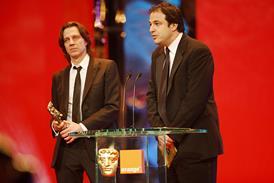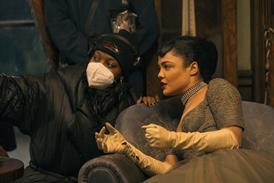Locarno is famed for its cinematic retrospectives and this year shines a spotlight on film from the golden age of Columbia Pictures, which celebrates its 100th anniversary.

Every film lover knows the Statue of Liberty-like Columbia Pictures logo that gives the Lady with the Torch, Locarno’s retrospective programme marking Columbia’s 2024 centenary, its title.
But even avid festivalgoers and cinema historians may not be familiar with some of the 40 features and four shorts made by Columbia between 1929 and 1959 that will be screening during the festival at the GranRex and other Locarno venues.
Retrospective curator Ehsan Khoshbakht explains that Columbia granted the access necessary to present the full picture of a Hollywood institution during the studio system’s golden age, taking in well-known award winners but also “guilty pleasures, new discoveries and films people have not seen before.”
The retrospective’s date range, 1929-59, overlaps neatly with the reign of infamous Columbia president Harry Cohn. So the retrospective also became, says Khoshbakht, “a study of one of the major Hollywood studio bosses, whose character, attitude and approach shaped the type of films produced by Columbia”.
Khoshbakht assembled the line-up by focusing on four areas of the studio’s output, restricting himself to one title per director and, with a few exceptions, one title per year. These self-imposed rules account for the absence of well-known titles such as It Happened One Night and The Bridge On The River Kwai.
Around a quarter of the films in the retrospective, says Khoshbakht, are classics, among them Robert Rossen’s 1949 political drama All The King’s Men, a US National Film Registry title, and Frank Capra’s “quintessential” 1936 screwball comedy Mr Deeds Goes To Town, one of more than 20 films the director made during his decade-plus with Columbia.
Another quarter of the line-up consists of lesser-known films by acclaimed directors, such as Raoul Walsh’s rarely seen 3D western Gun Fury (1953).
A third quarter covers early B-movies from directors who would go on to great acclaim, such as John Sturges with 1949 neo-western The Walking Hills. The fourth quarter takes in some of the Columbia films from the period made about or by women, a notable example being Dorothy Arzner’s 1936 Broadway drama adaptation Craig’s Wife.
“Harry Cohn had this reputation of being misogynistic, and indeed he was,” says Khoshbakht. “But at the same time he appointed Virginia Van Upp, the first female executive producer in the history of Hollywood. Columbia was the studio at which Dorothy Arzner made her finest work. And it was the studio of the screwball comedy, in which women had the power and the agency.”
The retrospective’s less obvious highlights, according to its curator, include films that reveal surprising and significant aspects of Columbia’s history. Early Hollywood actor and director James Cruze’s 1932 feature Washington Merry-Go-Round, for example, “shows that Frank Capra was not alone at Columbia making light-hearted, fast-moving pictures about political corruption,” suggests Khoshbakht. “It’s far more biting than Mr Smith Goes To Washington [Capra’s 1939 James Stewart comedy-drama], even though it was made earlier than the Capra movie.”
None Shall Escape, a 1944 war drama from André De Toth (House Of Wax), is “quite remarkable”, says the curator, “because it anticipates the Nuremberg trials. Columbia was surprisingly good at dealing with fascism during the war, in many different ways.”
Gunman’s Walk, a 1958 western by Phil Karlson, is “another major surprise”, reports Khoshbakht, “a very sophisticated widescreen western with Freudian themes.”
Preserving a legacy
Karlson’s feature — championed in recent years by Quentin Tarantino — is also an example of how Columbia’s present-day parent Sony Pictures Entertainment (SPE) is acting to preserve its legacy. According to Grover Crisp, SPE executive vice president of asset restoration and preservation, the film will be presented digitally at Locarno “in its original Cinemascope aspect ratio, something not seen theatrically since the 1950s”.
For Khoshbakht, the biggest challenges in assembling the retrospective were the viewing time involved — he watched at least one film from each week of the Columbia release calendar from each of the 31 years covered by the programme — and the scarcity of video copies of films from early in the period.
Dealing with Sony was the easy part, reports the curator. Crisp and SPE vice president Rita Belda, who will be in Locarno to participate in a panel about the retrospective, are “people who really want to put out the legacy of the studio in the best possible way,” says Khoshbakht. “These are people who care about the history of their studio.”
Crisp says the retrospective — organised in partnership with Cinémathèque Suisse and set to be presented in the months after Locarno at venues in Switzerland, Denmark, Austria, Spain, Germany and the Netherlands — fits in with Sony’s own preservation efforts.
“Because of our photo-chemical initiative throughout the 1990s and into the early part of this century, we have many 35mm prints that can be loaned out for screening,” explains the Sony executive. “While we have not embarked on any specific restoration of a title just for this festival, the selection of films coincided with titles that are part of our ongoing restoration of the library.”
In its scope and diversity, says Crisp, the retrospective “informs the cultural, historical and artistic contributions of the many filmmakers and studio managers over a key three-decade period of the studio’s existence.
Riding high: Columbia’s 100 years
Launched in the first weeks of 1924 by brothers Harry and Jack Cohn and their friend Joe Brandt, Columbia Pictures was originally one of the so‑called “Little Three” among the eight Hollywood studios. And, in its early years at least, “it was overwhelmingly a B-picture studio,” says Matthew Bernstein, professor of film and media at Emory University and one of the authors of Locarno’s book about the studio, edited and published by Les Editions de l’Oeil, that accompanies the retrospective.
It was Columbia’s long association with screwball comedy expert Frank Capra that began to give it prestige titles to go with its stock-in-trade of westerns, shorts and serial films. “No studio in history is so identified with one director as Columbia is with Frank Capra,” says Bernstein, who is also writing his own book on the studio with Eddy Von Mueller and will be a panel participant in Locarno.
In the 1940s and ’50s, Columbia began making bigger films, sometimes partnering with independents like Sam Spiegel, producer of On The Waterfront and The Bridge On The River Kwai. After president and production head Harry Cohn’s death in 1958, the studio continued its run of UK co-productions with Lawrence Of Arabiaand Oliver!.
The 1950s also saw Columbia become a pioneer in TV production through its Screen Gems division. And at the end of the 1960s, the studio discovered the youth market with its pick-up of Easy Rider, which led to a push “to cater to that market in a variety of ways through the ’70s”, says Bernstein.
In the final decades of the 20th century, Columbia went through two high-profile corporate takeovers — by Coca Cola in 1982 and Sony in 1989 — and two high-profile executive regimes. UK producer David Puttnam lasted little more than a year as studio head under Coca Cola while Batman producers Peter Guber and Jon Peters managed a total of five years under Sony.
In the new millennium, Columbia, operating as part of Sony Pictures Entertainment (SPE), found massive box-office success with its Spider-Man franchise, which has so far extended to eight live-action films and two animated features.
Recent corporate moves by SPE, meanwhile, have included the surprise acquisition of the Alamo Drafthouse US cinema chain and recently withdrawn bid, with asset management firm Apollo, for rival studio Paramount Global. Against this backdrop, it remains to be seen where Columbia’s lady will next carry her torch.























No comments yet